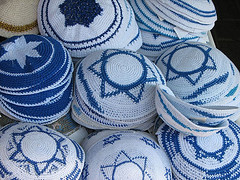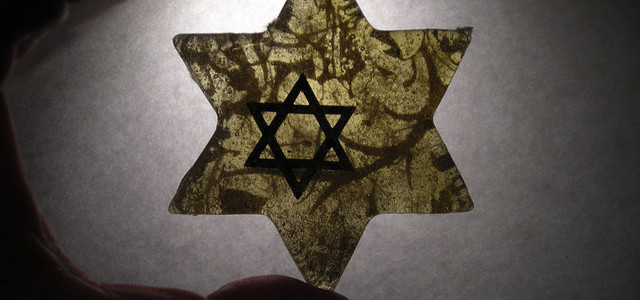 (This series of posts is by an anonymous couple who’ve decided to launch an experiment: a summer of church hopping. Every post will include the perspectives of each in a “she said/he said” format.)
(This series of posts is by an anonymous couple who’ve decided to launch an experiment: a summer of church hopping. Every post will include the perspectives of each in a “she said/he said” format.)
She Said:
Leaves are changing color. Summer is ending. What started as a short season of church hopping will almost certainly continue, although this will be our last post. For now. Why our last post? Both my husband and I work in higher ed, our kids are in school, and the demands of our daily lives have gone up several notches, leaving less time to write.
That brings me to yesterday’s adventure at a Jewish synagogue. I’ve wanted all summer to step outside the Christian mainframe and try something really different. Universalist Unitarianism and Quakerism both have roots in Christianity, although nowadays members don’t even have to be theist to attend. Going to a Jewish meeting would be the first real adventure into unknown waters.
Maybe that is partly why I felt so nervous as we made our way up the steps into the meetinghouse. We shook hands with the rabbi at the door, and I immediately felt the need to tell him we’d never been to a synagogue before and had no clue what we were doing. He was warm and welcoming, encouraging us to sit back and take it all in.
As it happens, we went to a Shabbat that was particularly for kids five and under, a “Shabbat for Tots,” or Jewish Primary. All the men in the room wore yarmulkes, which made my husband stand out uncomfortably. Before the meeting began, I explained to the kids as best as I could the menorahs at the front of the room and the Star of David hanging from the light fixtures.
The children gathered around the rabbi at the front of the room, but our kids were too shy to participate. They sat glued to our laps. There was lots of singing, most of it completely unfamiliar. The rabbi was wonderful at engaging the young children, teaching them through song about Shabbat and Jewish culture. He demonstrated the sound of a shofar (one of the horns that brought down the walls of Jericho). Towards the end of the service, he drew back the curtain to show the children the Torah scrolls. Then he popped open a large bin full of stuffed Torahs. Each child got to hold one as they followed the rabbi up and down the aisles like train cars, singing playfully.
I felt like a freshwater fish in the ocean. Some things were very familiar. I am very comfortable with the paradigm of engaging young children in activities, such as taking my kids to story time at the public library or teaching Sharing Time in an LDS Primary. At other times I felt terribly inadequately prepared. Why were they covering their eyes with one hand during a special prayer? Why did they sing their prayers? Why were all the prayers in Hebrew instead of English? I couldn’t really even tell my six-year-old why all the men and boys wore yarmulkes and the girls didn’t.
Wednesday, I discovered, is Rosh Hashanah, the Jewish New Year. If I’m brave enough, I may find myself at the synagogue that evening, doing what the rabbi advised: just sitting back and taking it all in.
;
Some Christian churches and denominations are firmly tied to an ethnicity, like the Greek Orthodox Church. Some are more loosely associated with one, like the midwestern Lutherans of Nordic stock that Garrison Keillor often talks about. Most don’t have such associations any more. A Christian congregation can be a pretty diverse bunch, at least as long as you define “diverse” as different varieties of European descent. Because of Christ’s injunction to take the gospel to the whole world, I’ve felt fairly confident that we would be welcomed at every church we visited this summer.
Judaism is different, though. It is a religion inextricably tied to an ethnicity. Jews are born Jewish and, as I understand it, aren’t much interested in winning converts. It’s kind of a shame because I am what could be called a “Judeophile.” I’ve studied some Jewish midrash. I’ve done research on Jewish-Christian relations in early modern Europe. I listen to Jewish folk music while I clean the house. I see Reform Judaism as a model for some possible Reform Mormonism in the future, less concerned with trueness.
That’s why we chose to attend a Jewish service as part of our Church Hop. The truth is that we didn’t really go to the real thing. On this particular Saturday, they were doing a “Tot Shabbat,” which was basically like a Primary class. We were nervous anyway. The rabbi that met us at the door was very friendly and welcoming, but he seemed surprised that a non-Jewish family would show up. That didn’t help my discomfort. Nor did the fact that there were only a small handful of families there. I didn’t know whether or not to put on a yarmulke, so I didn’t. This made me feel self-conscious. Our kids refused to go up to the front with the other kids, which just made us stick out even more.
Chances are, no one there even noticed or cared that we weren’t Jewish, but I couldn’t help but feel like an outsider. On top of that, the children’s songs, with Hebrew words interspersed throughout, were completely foreign to me. The combined effect was that I felt like a tourist in another country, gawking at the way people go about their lives. It was probably all in my head, but I didn’t like that feeling.
The truth is, though, we’ve been gawking all summer. It doesn’t matter that Christianity is more familiar and less tied to ethnicity. Visiting different congregations has been an adventure, but we haven’t gotten to know any of these churches in any depth. If, as Mormonism supposes, the purpose of life is to find the one true church, we’re going to need several lifetimes to get to know all of them well enough to decide which one that is. It’s fascinating to learn about other religions, and I plan to keep doing it, but now more than ever I can see that the purpose of life is not to find and adhere to the one true church. It is to cultivate goodness.

